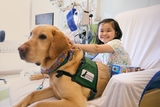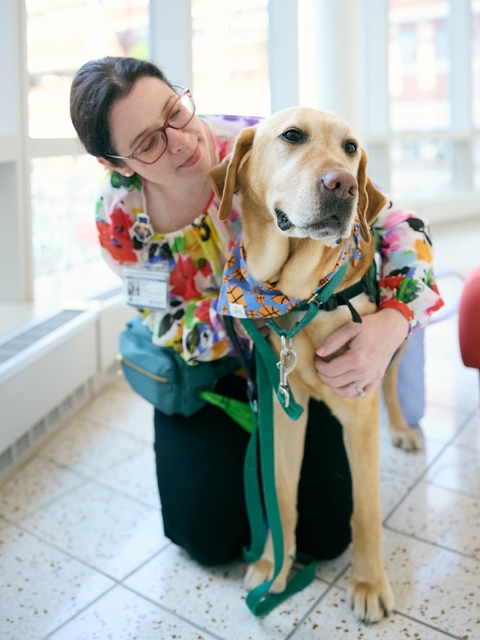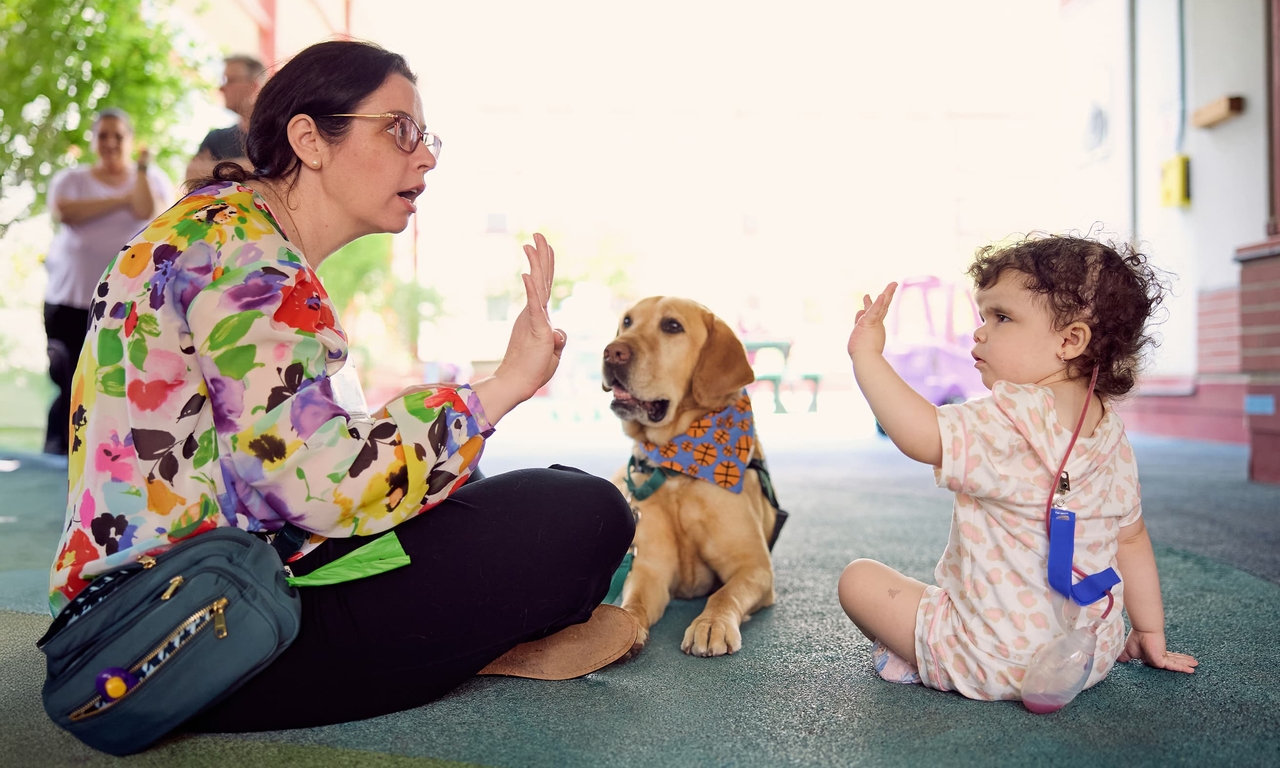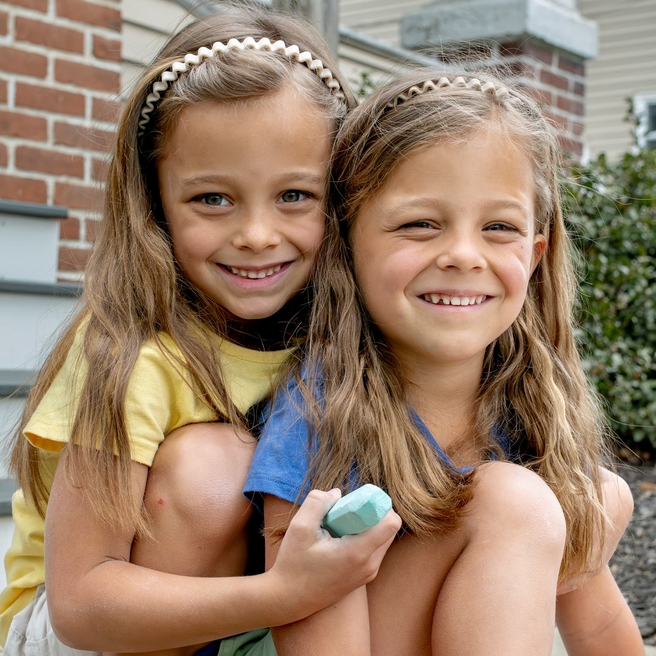
When a patient needs some extra support — preparing for surgery or going through a stressful procedure, for example — a visit from a CHOP facility dog might be just what they need to improve their mood and their health. Dilly is a CHOP facility dog. He lives with his handler, child life specialist Lizzy Olsen.
Facility dogs are full-time CHOP employees who are specially trained to help children with their treatment or recovery. CHOP currently has only two full-time facility dogs, so the need and goal is to expand the program. Unlike many service dogs, who should be left alone while they’re working, facility dogs welcome pets and visits (with permission of their handler) when they’re on the job. Volunteers also bring therapy dogs to CHOP through the Gerald B. Shreiber Pet Therapy Program.
Every day is different for Lizzy and Dilly — they may visit patients in their rooms, motivate physical therapy patients to get moving or facilitate therapeutic groups. This is a day in their life.
Getting into the flow

8 a.m. Lizzy and Dilly wake up, eat breakfast and walk around their neighborhood.
9:30 a.m. Time to leave for work. Dilly spends the 45-minute commute either snoozing or chomping on a large stuffed Bluey that’s equal parts BFF, security blanket and stress reliever.
The workday begins
10:30 a.m. Lizzy’s and Dilly’s hours run a bit later than a traditional 9-to-5 because hospital inpatients — most of the kids they help — are busy with their medical teams in the early mornings. “Shall we go see some kids, Dilly Pickle?” Lizzy asks him. Dilly gives a deep play bow — his way of saying “yes.”
10:45 a.m. A dialysis patient stops to chat with Dilly on the way back to her room. “Dilly, you better be coming to my birthday party in a few weeks,” she says. “It’s my Quinceañera.” Lizzy laughs and says they’ll be there. After the patient leaves, Lizzy reveals, “Not only will we be there, but Dilly will be in a tuxedo. We wouldn’t miss it.”
11:10 a.m. At the hospital’s outdoor play area, Dilly is briefly diverted by Nurse Jackie, who brings Lizzy banana chips as a treat for the pup. (His favorite snack is clementines.) Two-year-old Mya rides in a plastic car pushed slowly by her parents, two days after surgery to correct prematurely fused bones in her skull. She climbs out of the car to sit on the ground and pet Dilly — an impromptu visit.
Arts and crafts
11:30 a.m. Dilly meets 15-year old Cavan, who does physical therapy to manage the effects of a rare neuromuscular condition. Cavan and child life recreational therapist Ashley Anderson are making tie-dye bandanas, one for Dilly and one for Lindy, Cavan’s dog at home. Dilly rests his snout on the picnic table to watch Cavan work, and a little green dye splashes on his cheek. Lizzy laughs and quickly wipes it away.
A pilot program succeeds
12:15 p.m. The Facility Dog Program recently launched a pilot in the dialysis and apheresis wing to support patients facing long treatment times while their blood is filtered and cleaned. Nine-year-old Shelby has received successful gene therapy to cure a blood disorder, but the many transfusions she received prior to that caused excess iron to build up in her blood. Shelby is delighted when Dilly gently stretches across the foot of her recliner. She shows him the stuffed dog she brought along to keep her company. “Dilly looks tired,” Shelby tells Lizzy, and then Dilly rolls over to request a belly rub.
Break time and Bluey
1:15 p.m. Bathroom break! Lizzy takes Dilly outside to a designated grassy area. Dilly shows signs of stiffness, so Lizzy knows it’s time to recharge. They head back to their office, where food, water and Bluey await, along with a soft bed. While Dilly rests, Lizzy attends meetings and catches up on work.
The late afternoon shift

4 p.m. Dilly’s refreshed and ready to go. Occasionally Dilly helps with staff engagement, attending meetings and making connections between co-workers.
5 p.m. Rehab evening group begins. When Dilly is in the mix, kids practice turn-taking as they wait for a chance to pet him or ask him to do a trick.
6 p.m. Dilly and Lizzy are back at their desk, so Lizzy can chronicle the day’s work and address administrative requests.
7:30 p.m. Work is done! They head home for dinner and chill time.
Featured in this article
Specialties & Programs
When a patient needs some extra support — preparing for surgery or going through a stressful procedure, for example — a visit from a CHOP facility dog might be just what they need to improve their mood and their health. Dilly is a CHOP facility dog. He lives with his handler, child life specialist Lizzy Olsen.
Facility dogs are full-time CHOP employees who are specially trained to help children with their treatment or recovery. CHOP currently has only two full-time facility dogs, so the need and goal is to expand the program. Unlike many service dogs, who should be left alone while they’re working, facility dogs welcome pets and visits (with permission of their handler) when they’re on the job. Volunteers also bring therapy dogs to CHOP through the Gerald B. Shreiber Pet Therapy Program.
Every day is different for Lizzy and Dilly — they may visit patients in their rooms, motivate physical therapy patients to get moving or facilitate therapeutic groups. This is a day in their life.
Getting into the flow

8 a.m. Lizzy and Dilly wake up, eat breakfast and walk around their neighborhood.
9:30 a.m. Time to leave for work. Dilly spends the 45-minute commute either snoozing or chomping on a large stuffed Bluey that’s equal parts BFF, security blanket and stress reliever.
The workday begins
10:30 a.m. Lizzy’s and Dilly’s hours run a bit later than a traditional 9-to-5 because hospital inpatients — most of the kids they help — are busy with their medical teams in the early mornings. “Shall we go see some kids, Dilly Pickle?” Lizzy asks him. Dilly gives a deep play bow — his way of saying “yes.”
10:45 a.m. A dialysis patient stops to chat with Dilly on the way back to her room. “Dilly, you better be coming to my birthday party in a few weeks,” she says. “It’s my Quinceañera.” Lizzy laughs and says they’ll be there. After the patient leaves, Lizzy reveals, “Not only will we be there, but Dilly will be in a tuxedo. We wouldn’t miss it.”
11:10 a.m. At the hospital’s outdoor play area, Dilly is briefly diverted by Nurse Jackie, who brings Lizzy banana chips as a treat for the pup. (His favorite snack is clementines.) Two-year-old Mya rides in a plastic car pushed slowly by her parents, two days after surgery to correct prematurely fused bones in her skull. She climbs out of the car to sit on the ground and pet Dilly — an impromptu visit.
Arts and crafts
11:30 a.m. Dilly meets 15-year old Cavan, who does physical therapy to manage the effects of a rare neuromuscular condition. Cavan and child life recreational therapist Ashley Anderson are making tie-dye bandanas, one for Dilly and one for Lindy, Cavan’s dog at home. Dilly rests his snout on the picnic table to watch Cavan work, and a little green dye splashes on his cheek. Lizzy laughs and quickly wipes it away.
A pilot program succeeds
12:15 p.m. The Facility Dog Program recently launched a pilot in the dialysis and apheresis wing to support patients facing long treatment times while their blood is filtered and cleaned. Nine-year-old Shelby has received successful gene therapy to cure a blood disorder, but the many transfusions she received prior to that caused excess iron to build up in her blood. Shelby is delighted when Dilly gently stretches across the foot of her recliner. She shows him the stuffed dog she brought along to keep her company. “Dilly looks tired,” Shelby tells Lizzy, and then Dilly rolls over to request a belly rub.
Break time and Bluey
1:15 p.m. Bathroom break! Lizzy takes Dilly outside to a designated grassy area. Dilly shows signs of stiffness, so Lizzy knows it’s time to recharge. They head back to their office, where food, water and Bluey await, along with a soft bed. While Dilly rests, Lizzy attends meetings and catches up on work.
The late afternoon shift

4 p.m. Dilly’s refreshed and ready to go. Occasionally Dilly helps with staff engagement, attending meetings and making connections between co-workers.
5 p.m. Rehab evening group begins. When Dilly is in the mix, kids practice turn-taking as they wait for a chance to pet him or ask him to do a trick.
6 p.m. Dilly and Lizzy are back at their desk, so Lizzy can chronicle the day’s work and address administrative requests.
7:30 p.m. Work is done! They head home for dinner and chill time.
Recommended reading
All in one place

Genetic testing revealed that Audrey had a rare condition called Beckwith-Wiedemann syndrome. With so many different areas of the body potentially affected, a child needs to be seen by multiple specialists, and CHOP is just the place to help. Donor support helps make it possible.
Drawing from the Community

A unique program at CHOP trains residents of Philadelphia to become phlebotomists. It benefits participants, CHOP and patient families.
Newborns Get New Answers

A program called Baby Eagle spreads its wings by delivering rapid genomic sequencing to critically ill infants at no cost to families.
Contact us
Child Life, Education and Creative Arts Therapy